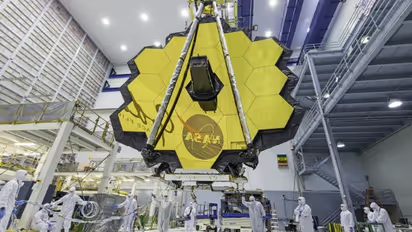NASA's James Webb telescope reaches final stable position, parked 15,00,000 km from Earth

Synopsis
The James Webb Space Telescope is NASA's scientific counterpart to the Hubble Space Telescope. It will be the most powerful space telescope that has ever been constructed.
NASA announced on Monday that the James Webb Space Telescope (JWST) successfully launched a scheduled rocket on-course correction to put itself into a permanent, stable position between the Earth and the Sun, about one million miles from its home planet.
"Today, at 2:00 p.m. EST, Webb fired its onboard thrusters for over five minutes (297 seconds) to perform the final post-launch course adjustment to Webb's trajectory," NASA said on its blog. "This mid-course correction fire put Webb into its final orbit at the second Sun-Earth Lagrange point, or L2, which is about 1.5 million miles distant from Earth," it added.
The massive golden mirror completely unfolded around 700,000 miles from Earth after taking off on Christmas Day last month. The ten-billion-dollar effort, spanning three decades and including NASA, the European Space Agency, and the Canadian Space Agency, aims to go further back in time than ever before in order to learn more about the formation of the earliest stars and the origins of our Universe.
Webb's discovery might help scientists comprehend the beginnings of the world and begin to address fundamental concerns regarding our existence, such as where we come from and if we are alone in the Universe. The James Webb Space Telescope is NASA's scientific counterpart to the Hubble Space Telescope. It will be the most powerful space telescope that has ever been constructed. Webb is a NASA-led worldwide initiative.
NASA, the European Space Agency (ESA), and the Canadian Space Agency worked together to develop the telescope. The telescope will be used by astronomers, scientists, and researchers to answer basic questions such as "Is Earth unique?" Are there other planetary systems like ours? Is it possible that we are the only ones in the Universe?
The telescope will look at the atmospheres of a variety of exoplanets. In the aim of uncovering the building blocks of life, it will also seek Earth-like atmospheres and traces of critical components such as methane, water, oxygen, carbon dioxide, and complex organic molecules.
Also Read | James Webb Space Telescope launch: World's largest, most powerful observatory successfully lifts-off